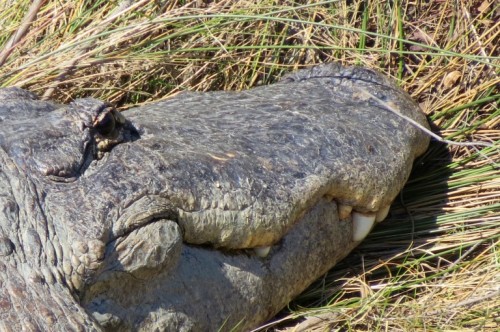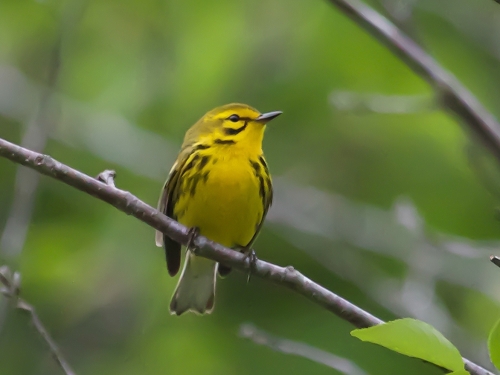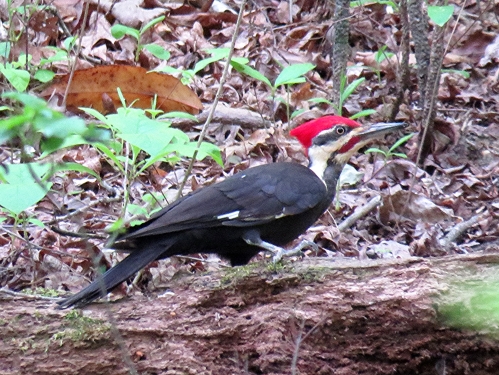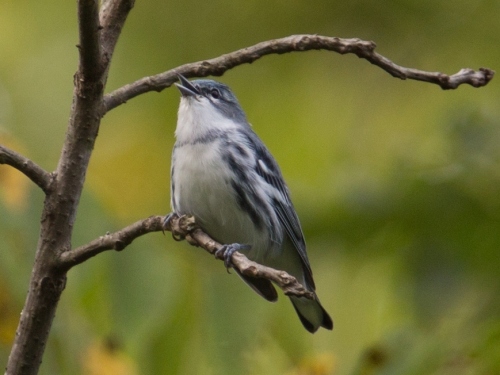By Cynthia Donaldson
This may have been the rainiest Forsyth Audubon trip I have ever attended. The rain started as we traveled south on I-95 on Friday, January 15, heading toward Santee National Wildlife Refuge. By the time we all arrived, it was raining in earnest. The inside of the beautiful visitor center was a great place to enjoy our picnic lunches. Many were enjoying the covered deck and scoping the Bonaparte’s Gulls, Forster’s Terns, and Double-crested Cormorants that were flying around Lake Marion. Loons and grebes were floating about, not seeming to be bothered by the steady rain. By 1 o’clock, the rain had stopped and, according to the radar, the front had passed. We hiked the Wright’s Bluff Nature Trail though a quiet pine forest to the edge of the impoundments where the birds find refuge in the winter.
From the observation tower, we enjoyed Wild Turkeys, Sandhill Cranes, Eastern Meadowlarks, Harrier and Cooper fly-bys, as well as Orange-crowned, Yellow-rumped, and Pine Warblers chattering behind us in the forest. Another quick rain shower divided the group: most headed back to their cars. The rest stayed for another hour watching the parade of ducks and passerines – just glad to be outside and not at the “office.” The rain continued off and on until evening.
Tony’s Famous Pizza chef served up some yummy pizza to our group; then we headed to the Hampton Inn at the Georgetown Marina to try to get a good night’s sleep before our greatly anticipated day at Tom Yawkey Wildlife Center.
This group is prompt. We pulled out of the hotel parking lot at 8:25 am on the dot on Saturday morning, drove the 10 miles to the end of the road at the Estherville Minim Creek and met Jamie Dozier, Wildlife Biologist and Project Leader for the Tom Yawkey Wildlife Center. Jamie was our wonderful tour guide for the day. He ferried us across the creek in a pontoon boat, depositing us on the other side at a nature lover’s paradise! Jamie’s assistant was unable to come, so Howard volunteered to drive the other van. Those of us in his van survived to tell…
We were privileged to see, although in a somewhat dormant stage, a newly discovered species of Hedge-nettle named Stachys caroliniana. Here is a link about the plant: New Species of Hedge-Nettle Discovered in South Carolina.
Our lovely stroll through a Live Oak grove was memorable. These massive trees housing moss and ferns have withstood many storms over their one hundred years.
From here we came out into open at the impoundments where we enjoyed seeing 99 American Avocets!
We always kept an eye looking up, because the clear, blue sky was full of surprises: Wood Stork, Black and Turkey Vultures, Bald Eagles, and a flock of White Pelicans delighted us by appearing over our heads.
The highlight of the morning was an adult Roseate Spoonbill flying overhead. It landed out of sight behind the wooded edge. The photo below is a juvenile that was in the same area. Several members of the group did the dance of joy for this long sought-after life bird. I heard someone say, “We can go home now.” In reality, none of us wanted this gorgeous day to end.
After several hours exploring these impoundments, Jamie shuttled us back to the vans. We picnicked in the warm sun under some Live Oaks. With sandwich in one hand and binos in the other, we watched Harriers skim the marsh and we listened to American coots “cooting.”
After lunch, we visited an impoundment where a huge alligator was napping with one eye on us.
Our next destination took us through a long leaf pine forest. All the eastern woodpeckers can be found at Tom Yawkey. We almost scored a home run for Mr. Yawkey: we saw them all but the Hairy! The Tom Yawkey Wildlife Center hosts many colonies of the protected Red-cockaded Woodpecker. The Red-cockaded Woodpecker was a life bird for many.
The rest of the day was spent on yet another impoundment. Here, several saw Mottled Ducks to add to their life lists. A bobcat ran across an open field. He stopped at the edge and looked back at us before disappearing into the edge. A Marsh Wren trilled at us from his cover in the reeds. A small torpedo whizzed over our heads, changed elevation to a few inches above the trail ahead – traveling straight down the center, then veered sharply to the right into the marsh. Like a flash. Merlin.
 The afternoon sighting-of-the-day was a little ventriloquist; we could hear him but could not find him…at first. He was so much closer that he sounded. In this photo you can see our group mesmerized by the sight of this little bird. Another life bird for most of us: Sedge Wren.
The afternoon sighting-of-the-day was a little ventriloquist; we could hear him but could not find him…at first. He was so much closer that he sounded. In this photo you can see our group mesmerized by the sight of this little bird. Another life bird for most of us: Sedge Wren.
The only thing that could tear us away was the fact that our dinner reservations were at 6 PM. We tried to end the day with another Red-cockaded Woodpecker, but happily settled for a Red-headed.
Since the tide was in, Jamie drove the swing bridge into place and we walked across the creek back to our cars.
Everything about this day had been perfect. Jamie was a very knowledgeable guide who patiently answered all our questions about this amazing refuge. The weather was warm and sunny. The people in our group were helpful and eager to teach. It was unanimous: we will return to the Tom Yawkey Nature Center! The sooner the better.
The dinner at Eddy Chacon’s was good. This restaurant was right beside the hotel so we walked over. Some of us stopped at the marsh behind the hotel on the way to see the Clapper Rails.
Sunday morning was cold, breezy, and rainy. Here are a few words that I used to describe the group that went birding that morning: nutty, crazy, diehards, optimists. The rain let up around 1 pm when a few more joined the ranks at Huntington Beach State Park. By then, it had improved to only cold and breezy. We hiked out the north beach trail to the jetty where we saw Least Sandpipers, Black Scoters, several hundred Dunlin, one Purple Sandpiper, and some very friendly Ruddy Turnstones.
Another interesting sight was a small flock of Bonaparte’s Gulls “pattering.” Their feet were barely touching the water as they hovered right above water along the jetty, plucking at unseen food from the tops of the waves. Ron told us that Storm Petrels feed in this same way. The name “petrel” is a diminutive form of “Peter,” a reference to Saint Peter; it was given to these birds because they sometimes appear to walk on the water.
The sun was lowering in the sky as we headed back to our cars. Most went back to the hotel to get ready for dinner. Four of us remained to continue searching for at least one of the sparrows that live near the sea. No luck.
Our count dinner at Pasteria 811 was delicious. When we did the count down, we came up with 131 species for the trip!
A few more hours of birding on Monday morning helped us to add a few more birds to the list. Several birders stopped at a hammock shop at Pawley’s Island to see what they could find and spotted a female Painted Bunting. Around 10:30 am, we found (thanks to Frank Lawkins) the reported female Common Goldeneye at Mullet’s Pond at Huntington Beach State Park. Killdeer were also added to the list. A final count of 135 was fantastic!
Even though we probably endured a few inches of rain and fairly low temperatures on two of the days, it was a great trip. I agree with Heather; our memories of our Winter Trip 2016 will always make us nostalgic.
Photo credits: Gail & Ferd Crotte, Cynthia Donaldson, Gregg Donaldson, Heather Moir































